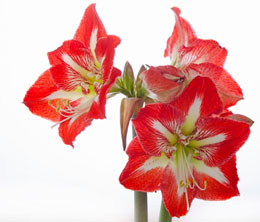The trumpet-shaped flower, amaryllis seeks no attention, yet manages to garner it. To ensure that your flowers do well, leaf through a few care tips given here.

A popular bulbous plant, the amaryllis flower is a monotypic genus of plant, also known as the Belladonna Lily, Naked Ladies, and the Loudspeaker. This flower is very popular among gardeners, as the varieties offer a stunning palate of colors. There are over a hundred varieties that offer amaryllis flowers that are single- or double-petaled, single or shaded colors, with many patterns―stripped, frilled edges, etc. They do well in beds, borders, edgings, and containers.
This plant is no more than two to three feet tall, and has long leaves of about 15 - 20 inches, with an inch in width. One bulb usually produces a couple of tall stalks on which three to four large trumpet-shaped flowers bloom in spring. The colors available are wide―red, bright pink, orange, rose, purple, salmon, white, and near white as well.
Planting the Bulbs: Amaryllis bulbs are easily available. Choose the bulbs as per the color scheme you plan to implement in your garden. They should be healthy, round or elongated, without any damage marks or infection. They should not have leaf sprouts, unless you purchase a potted plant. Indoor as well as outdoor care is more or less the same. For container gardening, choose a sandy-loam soil mix with a pH of 6.0 to 6.8, while for planting them in flower beds, elevate the soil about ten inches, and add a good measure of organic matter to ensure good drainage. Plant the bulbs deep enough to cover the root ball―the tip of the bulbs should be left to protrude outside. In flower beds, space the bulbs about 5 - 8 inches apart, to avoid overcrowding.
Basic Care: Water the amaryllis keeping the climatic conditions in mind―never let the soil dry out. The bulbs need moisture to renew their growth. A weeks time after planting the bulbs, one will notice leaf sprouts. A good amount of sunlight should be ensured for indoor plants. The plant will flower in 7 - 10 weeks―increase the water frequency when it begins to bloom. To ensure a longer blooming period, plant bulbs at intervals of 1 - 2 weeks. One can make the amaryllis flower again, after the flowering is over. Remove the dead head, cut back the flower stalk to the ground, and feed it with liquid fertilizer. A new stalk will spring up in a week's time.
Care After Blooming: After blooming, care basically involves ensuring the health and multiplication of the bulbs. After all the flowering is over, continue to water and fertilize the plant through spring and summer. The leaves should turn yellow and wilt away on their own―more leaf growth means bulb multiplication. Once all the leaves fall to the ground, dig out the bulbs from the soil. Shake off all dirt, trim excessively long roots, and dust some fungicide powder before storing them in a mesh bag in a cool dry place. Keep checking every few weeks for fungal growth. One can leave the bulbs in the ground too―just mulch around them to save them from the winter frost.
Proper care will ensure a good prolonged amaryllis flower show, while taking care of the bulbs will ensure that your stock keeps multiplying.






 A popular bulbous plant, the amaryllis flower is a monotypic genus of plant, also known as the Belladonna Lily, Naked Ladies, and the Loudspeaker. This flower is very popular among gardeners, as the varieties offer a stunning palate of colors. There are over a hundred varieties that offer amaryllis flowers that are single- or double-petaled, single or shaded colors, with many patterns―stripped, frilled edges, etc. They do well in beds, borders, edgings, and containers.
A popular bulbous plant, the amaryllis flower is a monotypic genus of plant, also known as the Belladonna Lily, Naked Ladies, and the Loudspeaker. This flower is very popular among gardeners, as the varieties offer a stunning palate of colors. There are over a hundred varieties that offer amaryllis flowers that are single- or double-petaled, single or shaded colors, with many patterns―stripped, frilled edges, etc. They do well in beds, borders, edgings, and containers.